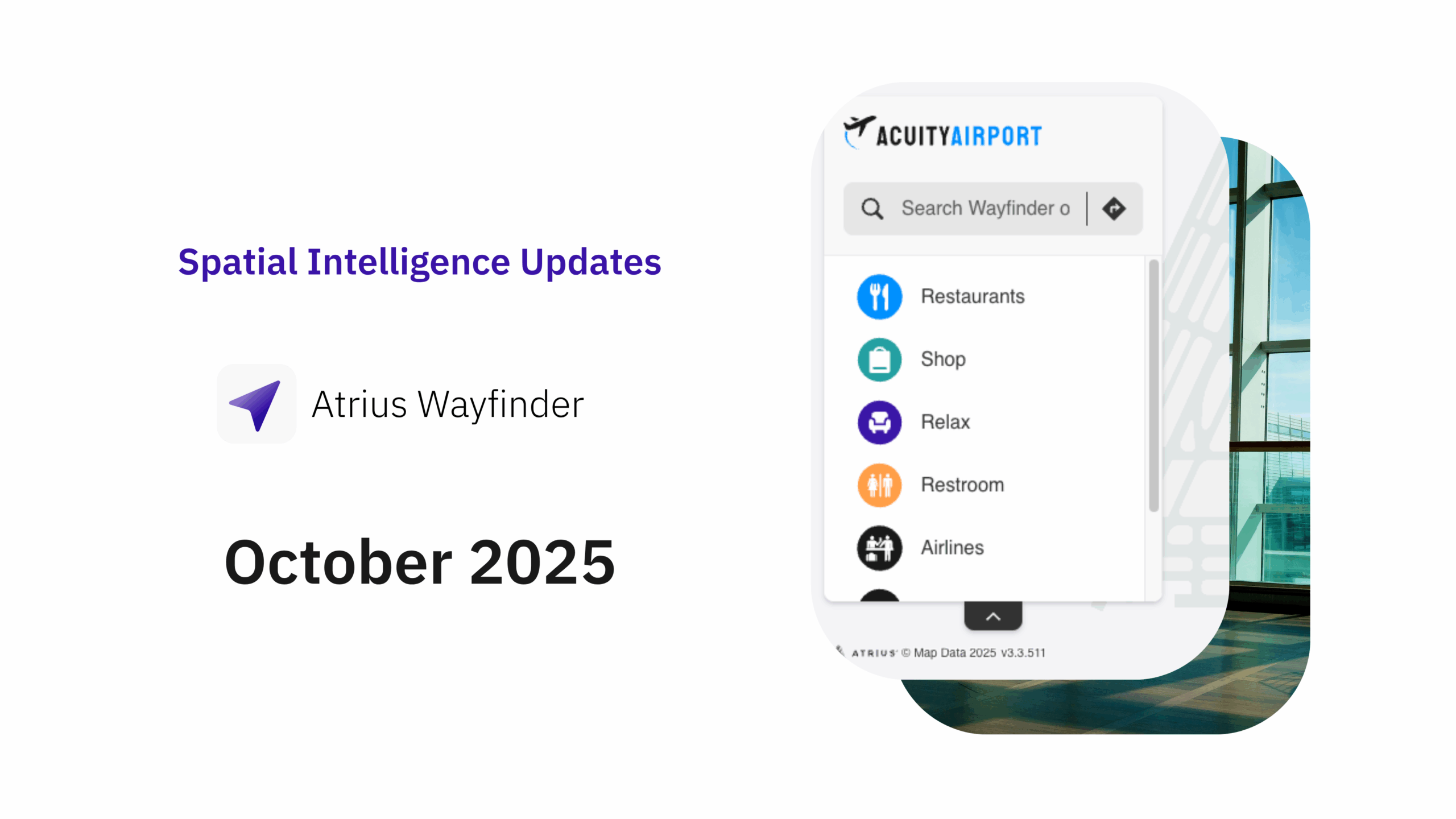Welcome to the first in our three-part blog series exploring Indoor Positioning Systems (IPS). We’re exploring its role within the technology landscape, the increasing number of applied use cases, and developers’ next steps to maximize IPS’ positive impact on any industry. This blog examines the evolution of IPS and the ways it has transformed the built environment. Part 2 of this series will detail how IPS can elevate customer experiences. Finally, in Part 3, you’ll meet Atrius’ newest product, Locator, and learn how we’re developing a future where IPS brings digital precision to physical spaces.
Unless they are intimately familiar with the term, most people don’t recognize the phrase Indoor Positioning Systems (IPS), know when they’re using the technology, or how it evolved. And yet, IPS is a 30-year-old technology impacting our lives through narrowly integrated applications in various industries.
The Relationship Between IPS & GPS
Global positioning systems (or GPS as it’s more commonly known) unlike IPS, is widely recognized and understood. Ask someone what GPS is, and you’re likely to get an oversimplified response about the technology that tells us where we are and how to get from point A to point B. While true, the more precise explanation is that GPS allows devices to calculate their locations using publicly accessible satellite infrastructure and triangulation of their generated signals. IPS can work similarly. IPS and GPS applications range from blue dot wayfinding or navigation to complete tracking and tracing workloads like supply chain management or process monitoring.

GPS typically can’t guide us inside the built environment. It will direct us to the hotel but won’t get us from the lobby to the conference room. As a generic technology, GPS also can’t understand specifics about indoor locations. It doesn’t process one space divided into multiple smaller areas, how items placed within a space affect operations, or how a specific space impacts people’s experiences within the building. IPS, however, can solve these challenges.
Similar to the early 90s when the internet was finding its feet, today’s relationship between IPS and businesses is still developing. We’re slowly unwrapping how to maximize the potential benefits.
“IPS is not a temporary fad with limited applications. Instead, IPS is cutting-edge technology on the cusp of widespread commercial adoption.”
From Innovation to Mainstream
Expectations 30 years in the making.
After 30 years of GPS directing us from our car dashboards, mobile devices, and now smartwatches, we are used to navigating to and from anywhere in the world. Anywhere outside, that is. So the interest in finding our way around inside, or locating specific items in a defined space is relatively new.
We can imagine the time savings and efficiency of having accurate location information indoors, but are we ready to integrate IPS into our lives as thoroughly as GPS?
In 1957 Everett M. Rogers and two colleagues developed the Rodgers Adoption Curve to explain how groups accept and adopt new ideas. Originally used in agriculture and home economics, their bell curve model applies to all types of innovative technologies, including IPS.
The technology adoption curve breaks into five categories describing people’s willingness and ability to accept new ideas and use the resulting products:
- Innovators
- Early Adopters
- Early Majority
- Late Majority
- Laggards
The rate of adoption, or how quickly a new technology moves through these groups, is critical to understanding if a new product or service will succeed. IPS is following the technology adoption curve. However, considering the complexity and cost of private infrastructure, IPS moved slowly through the early stages and is just now, given recent advances in IoT, smart devices, and sensor technologies, nearing the critical point of majority adoption.
Remember the early days of the iPod twenty years ago? The iPod was not the first portable MP3 player, it wasn’t even the best device on the market, yet it drove the technology across the proverbial chasm. In hindsight, the iPod solved the most significant usability problem associated with MP3 players: getting high-quality content onto the device. Putting music onto an MP3 player meant buying a compact disc, recording the music onto the PC, then manually editing various file attributes so it would work correctly on the MP3 player. The technology was popular with enthusiasts and DJs, but the effort required to load music prevented mass adoption. Apple brought the MP3 technology across the chasm by introducing iTunes as the companion music source. Broad acceptance of the iPod led to the iPhone and related innovations.
The technology adoption curve explains how demand for consumer products and business technologies increases. For example, while innovative, technology-forward organizations are already using IPS, specialized industries, like automated manufacturing, where unique operating needs justify the expensive IPS infrastructure. Retail, aviation, and entertainment are embracing IPS as well.
- Entertainment industries: Looking for your seat or the nearest concession stand in an 80,000- capacity arena? No problem, follow your IPS.
- Manufacturing: Can’t find three critical manufacturing components in the warehouse? IPS gets you to the items so you can get them to the production line.
- Retailers: Need a larger bag of dog food for a curbside pickup order? Turn on that IPS-enabled tracking device.
- Aviation: Want coffee or cookies before your flight departs? The airport map’s IPS will get you to both and back to your gate.
IPS is in the second stage of the adoption curve–on the precipice of the chasm–having successfully won over Innovators and Early Adopters. Company leaders are proactively assessing potential advantages against the uncertainty of unproven technology.
As described in his book, Crossing the Chasm: Marketing and Selling High-Tech Products to Mainstream Customers”, Jeffrey Moore calls bringing IPS solutions to mainstream applications crossing the adoption curve chasm. The term describes this as moving a product or service from Early Adopters to the Early and Late Majority groups. This enables a broad audience to achieve the promised value at reasonable costs. While not a trivial problem, once technology makes it possible, it simply requires identifying the value opportunity and applying engineering methods to make it accessible.
Will these move IPS across the chasm and toward the majority?

Leap forward with Atrius IPS solutions
Join us on the journey across the chasm by enabling your organization to achieve digital precision and practices over their physical spaces.
Atrius solutions go beyond granting you live access to your data. Our experience working with customers and partners over the past five years enables us to deliver finished experiences and solutions that will let you and your team achieve quick business value. We support your journeys along the technology adoption curve in multiple ways, including sharing articles like this to inform and energize progress.
Meet us at Part 2 of this three-part series, IPS & Indoor Wayfinding: Elevating Customer Experiences, where we talk about applying IPS to create richer shopper, employee, and visitor experiences.



